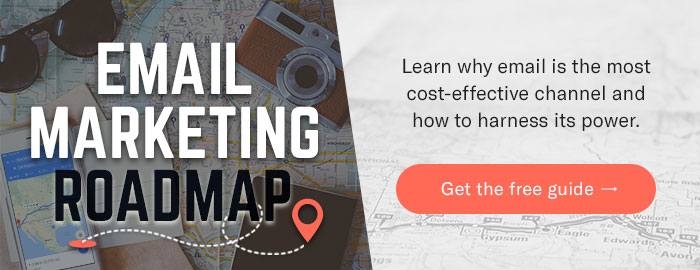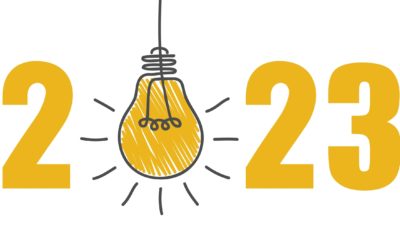Maybe it’s been awhile since you evaluated your email marketing efforts, and perhaps you’re not seeing the degree of connection with past, current and potential customers that you’d like. How do you achieve that sweet spot and connect with an email audience? Email marketing stats and reports can help you analyze your strategy and find success, but only if you understand how to use them.
Bonus Content: Grab a copy of our Email Marketing Roadmap.
Stats and best practices vary greatly across industries and the reports mentioned later in this post; there isn’t a universal standard that fits everyone. Each industry communicates with a different audience, and those reports analyze different segments of the population.
But you can still adapt benchmarks that use existing data and email marketing stats and make them work for you. We’ve gathered useful email marketing data. If your numbers don’t align with what we’ve found, it’s okay. We’ll help you figure out how to define what success looks like for your business. We’ve also created an Email Marketing Roadmap to decode best practices and help you achieve email marketing victories.
Here are some key email marketing stats that represent four important aspects of email marketing:
1. Email Open Rates
Your open rate is an important step in making a connection. You could provide the most groundbreaking information on the planet, but if nobody opens your emails to read it, you may as well send out blank emails.
Every time you prompt someone to open your email, you learn something about your effort. It may be:
- That you’re trustworthy and offer valued knowledge and insight
- That your subject lines are good at grabbing a customer’s attention
- That you have an opportunity to share effective content
Based on reported averages, a 20 percent open rate is where you want to aim. If your business falls in an industry with widely reported data, you may want to average existing values to set your benchmark.
Sources: Constant Contact, Optinmonster, MailChimp, Silverpop
Most importantly though, start with where you are now. Our 2017 Email Marketing Roadmap includes nine simple hacks to increase open rates. (Here’s a sneak peek: Change up your subject line, avoid the four-letter words, and don’t be afraid of negatives.)
Another area that affects open rates: whether your email campaign is mobile-friendly. According to Movable Ink, 62 percent of all emails are opened on smartphones and tablets. The highest spike is in the morning when users are most likely reaching for whatever device is on the nightstand. Are your emails mobile-friendly? They should be; otherwise, you could be missing out. [Tweet This]
2. Email Click-Through Rates
Average email click-through rates are another contentious stat, but not every email is meant to generate click-throughs. First, start by identifying the goal of your email. Some emails are transaction-related, some are informational, and others are meant to be forwarded. Maybe your email is meant to generate click-throughs to specific landing pages. Each type of email you send will likely have a different click-through average based on your desired call-to-action.
It’s also important to note that click-through rates are generally low percentages. MailChimp calculated a 2.8 percent average across 46 industries, while individual industry averages ranged from 1.46 percent to as high as 5.65 percent. Silverpop’s white paper on email benchmarks came in at 3.2 percent.
Aiming for a 3 percent average in email click-throughs makes sense given the recent statistics, but don’t ignore the average for your industry. Your audience may hold steady at a lower or higher rate, but it’ll vary depending on what types of emails you’re sending.
If you sent out an enticing offer requiring a click-through and only 1 percent responded, consider that a red flag and investigate further. Could you have crafted a better call-to-action? Could your email design use a refresher?
3. Email Subject Line Length
Will your subject line compel customers to open your email? Is the length of your subject line hurting or helping you?
Inc.com’s research claims the highest open rates (21 percent) when emails have six- to 10-word subject lines, which is roughly 50 characters in length. On the other end of the spectrum, Email Audience has found emails over 80 characters, especially those in the 100-character range, perform best. They reported a 115 percent increase in open rates of emails with 20-word subject lines over emails with shorter subject lines.
We’ve found 50 characters to be the rule of thumb when it comes to email subject line length. For best results, do some testing with your audience. Test shorter versus longer subject lines, as well as tactics like posing a question in the subject line. This is a great opportunity to do some controlled A/B testing.
Keep in mind that your subject line could trigger spam filters, keeping your emails from making it into an inbox. Our Email Marketing Roadmap goes over spam filters and subject line best practices more in-depth.
4. Send Date and Time
This may be the trickiest and most contentious aspect of email marketing. WordStream votes for Thursday between 8 a.m. and 9 a.m. for best performance, but Experian data points to later in the day, with an 8 p.m. to 4 a.m. send time and three best-to-send days of Friday, Saturday, and Sunday. MailChimp claims the best window is 2 p.m. to 5 p.m. on Tuesday, Wednesday, and Thursday. As you can see, experts are all over the board.
OutboundEngine has found that Wednesdays at 2 p.m. is the best time to send emails to our clientele. The key to determining your sweet spot for sending is getting to know your unique audience. If you try Thursday morning for a while then switch it to Saturday evening, for example, you will have numbers to compare. Just don’t forget humans are fickle and at times unpredictable. What worked during summer may not work during winter.
Wrap-Up
Now that your brain is full of percentages and conflicting information, let’s recap. Based on the averages of multiple industry studies, we’ve decided on the following email best practices:
- Shoot for an open rate of 20 percent
- With a click-through rate of 3 percent
- Subject lines should be around 50 characters
- And Wednesday at 2 p.m. is a prime time to send emails
Take these numbers with a grain of salt, as they vary across industries and audiences. Two people in the same industry could send the same email at the same time and get different results.
Have more questions? Check out our in-depth analysis of email marketing stats and best practices in our 2017 Email Marketing Roadmap and create your unique path to success.



![Better Email Etiquette Equals Better Marketing Results [16 Rules]](https://www.outboundengine.com/wp-content/uploads/shutterstock_411184843-1-400x250.jpg)

